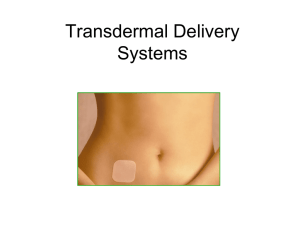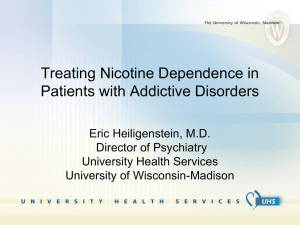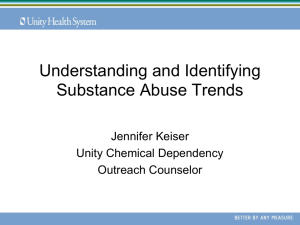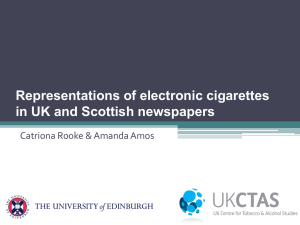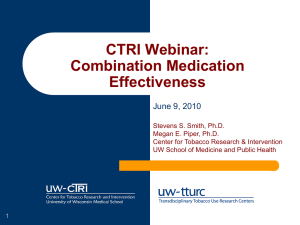Final Presentation
advertisement
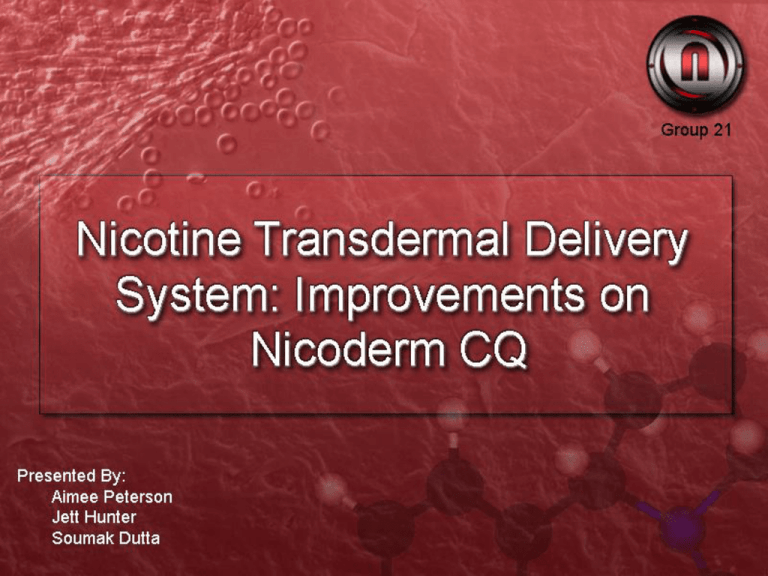
Health Effects of Smoking • Smoking is a major risk factor for many diseases – cardiovascular diseases – cancer – thromboembolic diseases • Carbon monoxide and oxidant gases in smoke responsible for cardiovascular system effects • ~ 1/2 smokers will die prematurely • Decreased life expectancy by ~ 8 years Cigarette Addiction • Nicotine is the addictive agent in cigarette smoke – activates brain reward areas – compulsive use – tolerance to adverse effects such as nausea and an acute increase in blood pressure and heart rate – withdrawal syndrome upon cessation • irritability, anxiety and dysphoria, cravings, poor concentration, increased appetite, sleep disturbance, drowsiness, decreased heart rate, and impaired task performance – tendency to relapse after cessation – persistent use even after learning of the adverse health effects of smoking Smoking Cessation Therapies • w/o professional help, 2% of smokers quit every year • Of these, < 20% remained abstinent after 1 yr • Market in US: 46.5 million smokers in 2000 & 70% (~32.6 million) wanted to quit • As nicotine is the addictive substance in cigarettes, nicotine is the ideal target for smoking cessation therapies Nicotine Replacement Therapies • Double quit rates • Do not increase rates of cardiovascular disease • Rarely cause addiction due to release profile • Include nicotine patches, polacrilex gum & lozenge, inhalers & nasal spray, and microtabs Transdermal Nicotine Delivery • Nicotine patch brands: Nicoderm, Nicotrol, Habitrol, Nicotinell • Easy to use • Increased patient compliance • Less user errors • Longer presence of nicotine in bloodstream • Constant nicotine levels maintained in plasma Nicoderm Committed Quitters • Nicoderm CQ • Attaches to skin and releases nicotine at a steady rate over 24h period • Program of tapering: – 6 wks using Level 1 (21 mg/day) patches – 2 wks using Level 2 (14 mg/day) patches – 2 wks using Level 3 ( 7 mg/day) patches Nicoderm CQ 21mg patch • ~ 22 cm2, 200-250 µm thick, 5 layers: – Backing – multilaminate of polyethylene/aluminum/ polyester/ ethylene-vinyl acetate copolymer – Drug reservoir – 40% nicotine base subsaturated in 60% ethylene/vinyl acetate copolymer (EVAc 40% VA), 13 μm – Rate-controlling membrane – high-density poly ethylene (HDPE) – 50 μm – Adhesive –blend of low and high MW polyisobutylene (PIB) in 90:10 ratio – 50 μm – Strippable release liner – fluorocarbon diacrylate/ polyethylene terephthalate (PET) Diagram of Nicoderm CQ patch Release in Nicoderm CQ • 35mg nicotine loaded into patches, ~21mg released over 24h • Steady-state rate of release is ~ 0 order • After application, up to 6h lag until therapeutic dose in bloodstream • Lag only for 1st application if patches replaced every 24h • If patches worn for 16h & taken off before bed, lag occurs every morning Mathematical Model of Flow • Qout DaKaDmKm A*∆C*t = DaKa + DmKm * L • where Qout is flow out of patch, D is diffusion coefficient of adhesive (a) and rate-controlling membrane (m), and K is partition coefficient • Km = Ka = K, Da <<< Dm • Qout KDa A*∆C*t = * L 0 T ime (hrs) 23.6 23.1 22.6 22 21.5 20.9 20.4 19.8 19.3 18.7 18.2 17.6 17.1 16.5 16 15.4 14.9 14.3 13.8 13.2 12.7 12.1 11.6 11 10.5 9.9 9.35 8.8 8.25 7.7 7.15 6.6 6.05 5.5 4.95 4.4 3.85 3.3 2.75 2.2 1.65 1.1 0.55 Nicotine (mg) Nicoderm CQ Cumulative Release 25 20 15 Series1 10 5 0 Delivery Rate vs. Plasma Conc. • where - Css = steady-state plasma conc. of nicotine - CL = clearance from blood - Q = nicotine flow from patch • b/c rate of release and plasma concentrations are directly correlated, reducing rate of delivery to ⅓ should also decrease plasma concentrations by ~ ⅓ Comparing Nicotine Release • Via cigarettes: – Each cig. provides ~1 mg nicotine – 20-28 mg absorbed daily – Plasma conc. maintained at 10-50 ng/mL • Via Nicoderm CQ: – Each patch provides 21 mg daily (⅞ mg/h) – Steady state plasma conc. maintained at ~10 ng/mL • Release from Nicoderm CQ at low end of spectrum for release from cigarettes Packaging • Kit containing 7, 14, or 21 patches • Each patch individually packaged in a tear-able plastic wrapper • Information booklet in kit Customer Complaints • Overnight nicotine delivery led to sleeplessness • Nervousness, anxiety during daytime • Adhesion lost after sweating/showering • Behavioral addiction not addressed • Directions on box indicate which level (7, 14, or 21 mg) patch to wear based only on number cigarettes smoked per day • Expensive Customer Requirements • Deliver nicotine over 24h period – Enough in morning to overcome strongest cravings – Less at night, so no sleeplessness • • • • Adhere under wet and dry conditions Not cause skin irritation Occlusive backing (no oozing) Cost ≤ cigarettes Redesign Objectives • Decrease rate of overnight release – Three variants • Decrease morning lag time • Increase adhesiveness – Use different adhesive • Address behavioral addiction – Quit Smart plastic cigarettes • Overcome objections about expense – Compare individual patches to cigarette cost on box label • Increase safety of disposal & Improve ease of package opening – Package individual patches in resealable packages Variants • Tabbed nicotine patch • Modified single membrane • Double-reservoir patch Tabbed Nicotine Patch Advantages: • User Controlled • Flexibility • Allows Lower NightTime Release Disadvantages: • User Input Required • Tab Strength • Tab Irritation • Edge Considerations Modified Single Membrane • Nicotine in patch: 24mg • Diffusion Coefficients: – Membrane: Dm = 65*108 cm2/hr – Adhesive: Da = 30*107 cm2/hr • Membrane thickness: 40 μm • Area of patch: ~ 24 cm2 • Rate of release: 1.1 mg/hr Modified Single Membrane • Provides 24 hr release • Rate of overnight release decrease • Rate starts to decrease at 16 hrs • Graph: Total release of nicotine over 24 hr period Double-reservoir patch • 7 layer patch: – Backing – Drug reservoir – overnight release – Rate-controlling membrane – Drug reservoir – daytime release – Rate-controlling membrane – Adhesive – Strippable release liner Mathematical Model • Qout DaKaDmbKm A*C2*t = * DaKa + DmbKmb L • C2 = C2(i) – Q(out) + DmtKmtDr2Kr2/(DmtKmt+Dr2Kr2)*A*C1*t/ L • This displays that the rate can be controlled by the thickness of the membrane Membrane Thickness • Rate-controlling membrane (also HDPE) for overnight release is 3x as thick so overnight release is 1/3 of daytime release • Drug reservoirs 4 µm thick (~⅓ thickness) since drug loading is ~⅓ (conc. of nicotine in 2 reservoirs is equal) • Slower membrane 117 µm thick • Faster membrane 39 µm thick Ideal Release Time(h) Mass1(mg) Mass2(mg) Flow(mg/h) ∆Mass(mg) • Each 1 11 11 0 0 2 10 ⅝ 10 ¼ 1⅛ 3 10 ¼ 9½ 1⅛ 4 9⅞ 8¾ 1⅛ 5 9½ 8 1⅛ 6 9⅛ 7¼ 1⅛ 7 8¾ 6½ 1⅛ • Flow out 1 ½ of lower 1 ⅞ reservoir is 2 ¼ 1⅛ mg/h 8 8⅜ 5¾ 1⅛ 2⅝ 9 8 5 1⅛ 3 10 7⅝ 4¼ 1⅛ 11 7¼ 3½ 1⅛ 12 6⅞ 2¾ 1⅛ reservoir ⅜ starts with ¾ 11 mg 1⅛ • Flow out of upper 3⅜ reservoir is 3 ¾ ⅜ mg/h 4⅛ Ideal Release Cont. Time(h) Mass1(mg) Mass2(mg) Flow(mg/h) ∆Mass(mg) 13 6½ 2 1⅛ 4½ 14 6⅛ 1¼ 1⅛ 4⅞ 15 5¾ ½ ½ 5¼ 16 5⅜ ⅜ ⅜ 5 17 5 ⅜ ⅜ 4⅝ 18 4⅝ ⅜ ⅜ 4¼ 19 4¼ ⅜ ⅜ 3⅞ 20 3⅞ ⅜ ⅜ 3½ 21 3½ ⅜ ⅜ 3⅛ 22 3⅛ ⅜ ⅜ 2¾ 23 2¾ ⅜ ⅜ 2⅜ 24 2⅜ ⅜ ⅜ 2 • For 1st 16h, 1⅛ mg flows out of lower reservoir as ⅜ mg flows into it •For last 8h, upper membrane determines flow Theoretical Drug Release Time (h) 23.8 23 22.1 21.3 20.4 19.6 18.7 17.9 17 16.2 15.3 14.5 13.6 12.8 11.9 11.1 10.2 9.35 8.5 7.65 6.8 5.95 5.1 4.25 3.4 2.55 1.7 0.85 0 Nicotine (mg) Cumulative Drug Release 20 18 16 14 12 10 Series1 8 6 4 2 0 Morning Lag Time • When Nicoderm CQ patches worn 16h, lag of up to 4h before therapeutic plasma conc. • No lag when patches worn 24h and replaced, but if patch taken off before bed, lag every day • With double-reservoir patch, slight lag in morning b/c overnight release low • However, lag is shorter b/c: – some overnight release – daytime release higher than in Nicoderm CQ Adhesion • Current adhesive does not adhere to skin when wetted • Equate nicotine patch does adhere, both when sweating and when showering, although more irritation when removed • Level of irritation is not high enough to counter benefit of good adhesion • Use adhesive used in Equate patch QuitSmart Cigarettes • Studies show that using the patch in conjunction with other behavoiral therapies increase rate of success • In one study, ⅔ of those who used the QuitSmart kit to quit remained non-smokers after 6 mo. • BetterQuit Cigarette Substitute can be ordered online • Cost is doubled due to shipping charges QuitSmart Cigarettes • QuitSmart not well advertised • Increased awareness can be obtained by including info in information booklet contained in Nicoderm CQ kit • Alternatively, if BetterQuit Cigarette Substitute included in some Nicoderm CQ Level 1 kits, total cost for consumer lowered Cost Comparison • Cost is nearly equivalent – One pack of cigarettes costs ~ $3 – 4 – One patch costs < $4 – One 24 h patch equivalent to 24 h of smoking for pack-a-day smokers • Objection to cost of patches a hurdle • Caption on label of box: “Costs the same per day as a pack of cigarettes!” Resealable Packaging • Current packaging used for individual patches hard to tear, often must be cut • Nicotine in disposed patches harmful to pets & children – ~14 mg of nicotine left in patch AFTER USE • Resealable, ‘ziplock’ package – easier to open – can be used to seal old patches prior to disposal Questions?



